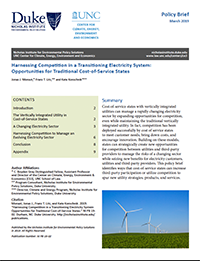Publications
Congressional Testimony of Tyler H. Norris of Duke University—Hearing on Scaling for Growth: Meeting the Demand for Reliable, Affordable Electricity
Increased need for electricity is driving elevated demand for power companies to rapidly build out their generation capacity. But Nicholas Institute research shows that, with strategic timing of load use, such demand could be met by the existing power grid.
Rethinking Load Growth: Assessing the Potential for Integration of Large Flexible Loads in US Power Systems
A key solution to the United States' soaring electrical demand—driven by unprecedented electricity needs from large commercial customers, particularly data centers and their booming artificial intelligence workloads—is load flexibility. This analysis provides a first-order estimate of the potential for accommodating such loads with minimal capacity expansion or impact on demand-supply balance.
Beyond FERC Order 2023: Considerations on Deep Interconnection Reform
In late July 2023, the US Federal Energy Regulatory Commission (FERC) released its much-anticipated rule on interconnection reform, Order 2023. This policy brief explores a deeper reform option known as connect and manage. This less restrictive interconnection approach could speed the deployment of resources in a way that can be managed after their integration with the grid, leading to a larger volume of interconnected generation capacity without sacrificing reliability.
Western Electricity Emerging Markets: State-Level Regulatory Analysis
After decades of failed proposals, the Western United States stands on the precipice of a regionalized electricity market. Current momentum exists in large part because of the success of extant real-time energy imbalance markets, stood up first by the California Independent System Operator in the mid-2010s and more recently by the Southwest Power Pool.
Coalition Stability in PJM: Exploring the Consequences of State Defection from the Wholesale Market
Using a simulation tool, the authors investigate the effects created by a US state defecting from the wholesale electricity market in an organized electric grid on the states that remain in the coalition. The report finds that if a net-importing state defects, the remaining states’ producers are worse off and the remaining states’ consumers are better off. The opposite effect takes hold if the defecting state is a net-exporter. Furthermore, the authors find evidence that defection impacts the remaining states’ climate initiatives.
Carbon Pricing in Wholesale Energy Markets
As states advance their climate policies with ambitious clean energy targets, wholesale market operators are grappling with questions about if and how electricity markets should evolve as a response. Several ISO/RTOs are looking to change their market rules to include carbon pricing, but there is a diversity in approaches.
Evaluating Options for Enhancing Wholesale Competition and Implications for the Southeastern United States
Given stated stakeholder clean energy and consumer goals, this paper offers a way to evaluate options for enhancing competition, compared to how utilities traditionally operate the electricity grid. The focus here is on wholesale transactions between generators and utilities serving end-use customers. These utilities then sell electricity at retail to their customers, and in many regions including the Southeast, they are state-regulated monopolies responsible for serving their customers at least cost.
Competition Case Study—The Southern Grids: 2000–2006
This case study lays out the four Southern proposals submitted to FERC, and chronicles how this directive played out in the South. In a sidebar, the case study also describes the retail competition vision being explored in North Carolina during the same time period. While the Southern Grids did not launch, the GridSouth (in the Carolinas) and the GridFlorida proposals reflect a concerted effort by the participating utilities to explore market creation, as well sustained engagement – and some support – by regulators and stakeholders.
Harnessing Competition in a Transitioning Electricity System: Opportunities for Traditional Cost-of-Service States
Cost-of-service states with vertically integrated utilities can manage a rapidly changing electricity sector by expanding opportunities for competition, even while maintaining the traditional vertically integrated utility. In fact, competition has been deployed successfully by cost of service states to meet customer needs, bring down costs, and encourage innovation.
State Participation in Resource Adequacy Decisions in Multistate Regional Transmission Organizations
The fight over which resources power the grid and how much is required has intensified as flattening electricity demand, low natural gas prices, and preferences for non-emitting technologies push less efficient power plants to retire. The focus has been on substantive solutions, and most recently on attempting to “accommodate” state energy policies in the regional electricity markets—with disappointing results to states, consumer advocates, and clean energy businesses. Missing from this debate is process reform.










